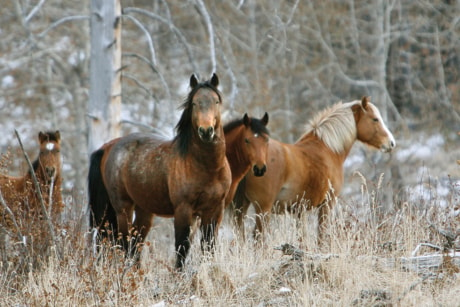The president of a society dedicated to preserving Alberta’s wild horse population is dismayed that more than 200 were rounded up this past season, a huge increase over past years.
“They’ve put an unbelievable dent (in the population),” said Bob Henderson, who heads the Wild Horses of Alberta Society. Most of the horses gathered in the scenic country west and north of Sundre will end up in slaughterhouses, he said.
Alberta Sustainable Resource Development says 237 permits were issued and 216 horses taken from December to the end of February as part of a program to control the horse population through humane capture. The average in recent years has been about 30 horses.
By Henderson’s count, as few as 500 or 550 wild horses roam the West Country, meaning about 40 per cent of the population could be gone.
He fears pressure from owners of livestock grazing rights and forestry companies will lead to similar-sized roundups in coming years, reducing population to dangerously low levels.
“You get down to 100 animals and then the gene pool can be so corrupted that you start getting your in-breeding and stuff like that.”
Sustainable Resource Development spokesman Dave Ealey said the number of horses taken was in keeping with the strategy of keeping the population to a size where it was not doing too much harm to the area’s environment. The horses can be destructive by disturbing re-generating trees planted by forestry companies or by eating grasses used by other animals, including deer, elk and cattle.
“Basically it’s the increase in the number of these animals that has become the concern,” he said. “We want to be able to manage their impact.”
The province considers the horses feral — either abandoned or escaped animals and their offspring — not wildlife.
A department survey showed the horse population had increased from 650 two years ago to 1,000 before the most recent cull. Population increases were likely due to mild winters and horse owners turning more animals loose to make their own way in the wild.
“We have documented evidence of these numbers,” Ealey said. “The wild horse advocates do not have our data.
“While I certainly support their enthusiasm for the species, it’s not without its impacts.
“And we are responsible for managing public lands for multiple uses and the types of uses that are going to sustain the types of ecosystems we’ve got there.”
The average of 30 horses taken over the last few years also takes into account seasons were almost none were taken because it was unclear how many horses there were.
Ealey said no specific target population has been determined, but they know a population of 200 is too low.
“We’re willing to have feral horses there. We’re not out there to eradicate them.”
Henderson believes the unprecedented cull is a direct result of a government that at best tolerates the wild horses, but would be just as happy to see them gone.
He dismisses claims the horses are damaging the environment.
“It’s not true,” he said, pointing out that 10,000 cattle are grazed in the area every summer and eat a lot more than any horses.
Henderson suspects that pressure from logging companies and those holding grazing leases in the area prompted the big boost in captures.
Forestry companies “say the horses are ruining the environment and damaging it out there. That’s bull too.
“We can show that the horses actually benefit the new seedlings and stuff like that.”
The horses aren’t pushing other wildlife out of grazing areas either, he said.
“Everywhere we go, where there’s horses you’ll find other wildlife. When you don’t find the horses, you don’t find too many other animals neither.”
An online petition to save the wild horses is on the society’s website and those concerned are urged to write letters to the premier or their MLA.
The horses are part of the province’s heritage, he said.
“Our current government or Sustainable Resource Development is just looking at them as just being feral and pests and stuff like that instead of being beautiful and natural.”
pcowley@www.reddeeradvocate.com
